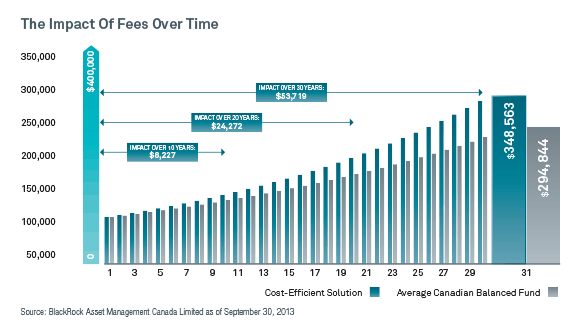How to Understand Mutual Fund Fees
Post on: 24 Май, 2015 No Comment

If you want to understand mutual fund fees and how they impact fund performance. its important to first understand our terms. The mutual fund industry likes to keep their vernacular nice and muddy so you dont question what they do with your money. Lets unravel that mess right now so you can fully understand what you are looking at before buying a fund.
NAV
“NAV” is your key to understanding fund fees. “NAV” stands for Net Asset Value. NAV is calculated by adding up the market value of all the mutual fund’s holdings at the end of the day. Then, they take that figure and subtract the daily expense the fund charges (more on that in a bit). The fund takes that result and divides it by the number of shares that are held by investors. The result is the “NAV”. Mutual funds have to calculate and report NAV every day. This is part of the quote you see online or in the paper. Simple example. If a fund has net assets of $1,000,000 and 100,000 shares outstanding, the NAV is $10 per share. Bueno?
Now, before we go on, I’d just like to point out something really important you may have overlooked. Since fund fees are subtracted daily, the NAV and the return you see for the fund is net of all expenses.
So, if you buy a fund for $10 a share and sell those shares for $11, you will gain $1 per share. That quote of $11 is shown after expenses. (It gets a bit more complicated when dividends are declared and reinvested. I’ll deal with that in a different post.)
What kinds of fees do funds charge?
If you read the mutual fund prospectus. you’ll know exactly what kind of fees your fund charges. There are management fees, administrative fees and even marketing fees. All told, they could add up to less than .15% or to more than 3% each year. If you really want to understand what your fund is charging you, you must read the prospectus and statement of information. There is no other way to really get this info.
Do fund fees matter?
Kinda sorta. Since fund fees are deducted from the NAV before performance is calculated and reported, a fund with higher expenses would theoretically have worse performance than a fund with lower expenses all else being equal. If you are a buy and hold investor (not what I recommend) you’d likely want to invest in those funds and ETFs with the very lowest fund fees and stick to them. In this case, fund fees are really important.
But if you are a performance based investor and you reallocate your money based on relative performance (like I do) allow the performance to drive your buy and sell decisions. If the funds with the lowest cost have the best performance, they will float to the top of your list. If the funds with the lowest expense don’t perform well, why would you want to own them? You are not in the “own the least cost fund business”. You are in the “let’s get great performance on a risk-adjusted basis business”. If you look at top performers over different time periods, youll rarely see the cheapest funds dominate the top positions. This proves the point compadre.
In other words, if you are managing your portfolio based on performance, and if a fund is able to deliver great results even with higher fees, you should buy that fund anyway.
Where do you stand on fund fees? Do you base your investment decisions on fund expense? How has it worked for you?














